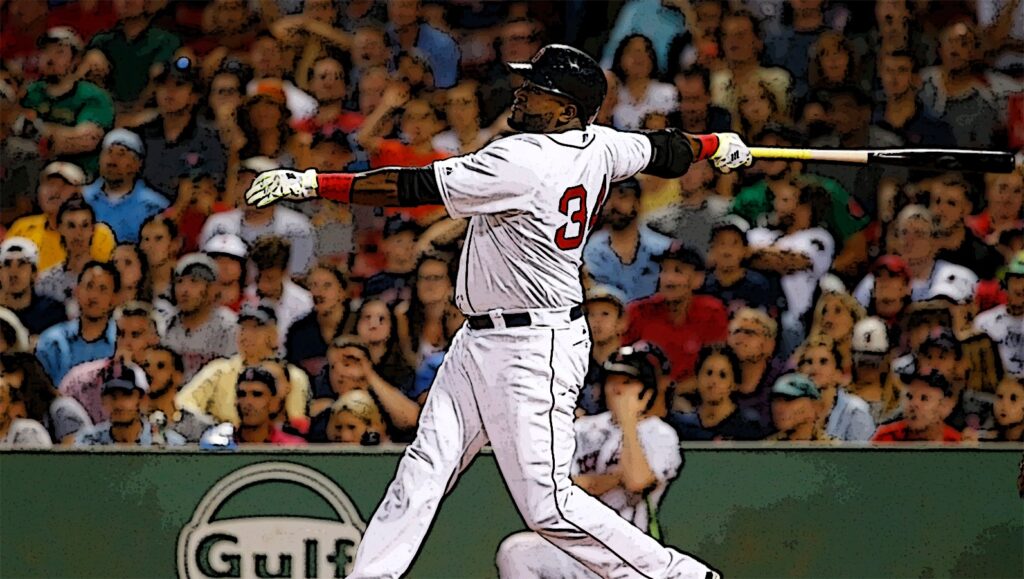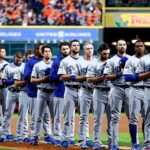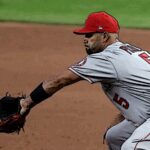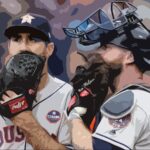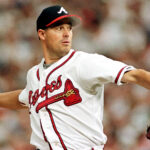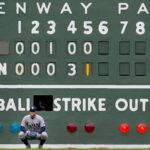When learning about the positions in baseball, the first thought that comes to mind is “how many players are on the field?”.
For those that don’t know, the answer is 9 for most, if not all professional leagues including MLB.
The positions are divided into three components: the battery, the infield and outfield.
The battery makes up the pairing of the pitcher (P) and catcher (C).
The infield consists of a the first (1B), second (2B), third baseman (3B) and the shortstop (SS) – 4 in total.
Lastly, the outfield makes up the difference and consists of the left (LF), center (CF) and rightfield (RF).
That said, when you see a player with a DH by their name, you may be confused.
While the player is part of the gameday lineup, they do not represent any particular position on the field.
So, what is it exactly? Let me explain…
What does DH mean in Baseball?
DH is acronym for designated hitter in baseball. The designated hitter is a position in the batting lineup that is used in both the American and National League as of 2022. The designated hitter was first introduced to American League in 1970s as a way to increase offense and appeal to fans.
In essence, rather than have the pitcher step up to the plate, you put a trained hitter in place.
That way you leave the pitchers to improve on pitching, while the additional batter can focus on their hitting exclusively.
In any case, most designated hitters also happen to be your team sluggers.
As a note, the DH rule exclusively applied to all AL hosted game for 49 seasons with some exceptions between 1973-75.
It was eventually adopted universally starting from the 2022 MLB season.
It’s to remain in place at least until the conclusion of the current Collective Bargaining Agreement (which ends in 2026).
When did the Designated Hitter rule start?
The DH rule was first introduced to the American League in 1973.
The MLB adopted the change on a 3-year trial basis.
The rule only applied during the regular season. Meaning that from 1973-75, all pitchers were still required to hit during the World Series.
But, by 1976, the DH position was ratified permanently in the rulebook.
Back then, the only time an NL and AL played each other was in the World Series Finals.
So, from 1976-85, the DH rule applied to both teams during even numbered years.
From 1986-2021, a designated hitter was required for teams in which the matchup featured two AL teams or if an interleague game was hosted by the AL team.
Otherwise, any interleague game hosted by an NL team required the pitchers to step up to the plate.
But as of 2022, the designated hitter was adopted by the National League as part of the 2022-26 Collective Bargaining Agreement.
The requirement for pitchers to bat has been completely phased out from professional baseball.
That said, here are some interesting facts about memorable pitcher at-bats for both the American and National league in baseball.
The last pitcher to ever hit a homerun in an American League matchup was Roric Harrison of the Baltimore Orioles in 1972.
It was on October 3rd of that year in a game against the Cleveland Indians.
Note that there have been other AL pitchers to hit homeruns in interleague play.
But the final ever homerun before the DH rule was implemented universally was by a National League pitcher.
That pitcher is none other than Logan Webb of the San Francisco Giants on October 10, 2021 against the San Diego Padres.
If the DH rule is in place for good, Webb will be the name for future trivia questions relating to the last pitcher to ever hit a homerun in MLB.
Can the DH play the field during a game?
The rules for playing a designated hitters on defense is pretty straight forward.
If a player serving as the designated hitter (DH) is later required to play a defensive position, he will still maintain his spot in the batting lineup.
However, once the player starts playing in the field, his team will no longer be able to use a DH to bat in place of the pitcher.
Additionally, if the pitcher moves to a different defensive position, if a player pinch-hits for another player and then becomes the pitcher, or if the current pitcher pinch-hits or pinch-runs for the DH, the team will be prohibited from using a DH for the remainder of the game.
And if a team chooses to, they can convert their designated hitter to a fielder from game to game without any penalty.
Under these circumstances, another player will take their place as the designated hitter per team’s discretion.
Most Notable Designated Hitters in MLB History
The biggest names that come to mind for the DH include Frank Thomas, David Ortiz and Edgar Martinez.
But all these players did play the field at some point in time, usually at the beginning of their careers.
I’m not aware of any player who spent their entire career as a designated hitter that were as effective.
That said, below is the exact list compiled by the Bleacher Report. You can read their justification for their top 10 here.
But these names come up regularly in notable designated hitters in MLB history.
Top 10 Designated Hitters of All-Time
| Player Name | Homeruns (as DH) | |
|---|---|---|
| 1 | Edgar Martinez | 243 |
| 2 | David Ortiz | 236 |
| 3 | Frank Thomas | 269 |
| 4 | Harold Baines | 235 |
| 5 | Chili Davis | 200 |
| 6 | Travis Hafner | 200 (Active) |
| 7 | Jim Thome | 205 |
| 8 | Paul Molitor | 102 |
| 9 | Hal McRae | 143 |
| 10 | Don Baylor | 219 |
Final Thoughts
The Designated Hitter has always left me with mixed feelings in baseball.
I grew up a Montreal Expos fan and followed the National League more closely.
The moment I saw the pitcher at the plate, I would usually roll my eyes.
You’d pray they’d know how to read the opposing pitcher as they are pitchers themselves – but that was rarely the case.
However, the Expos did have a pitcher who managed two homers in a season. His name was Felipe Lira.
At least he did give me a sliver of hope each time he reached the plate.
Unfortunately, his tenure with the Expos and the league was short-lived.
That said, it always seemed weird to me to have a player with the ability to crank a ball, but no defensive skills whatsoever.
I always viewed hitting to be more difficult than the easiest position in fielding.
That would be the outfield, as they usually have the least amount of work to do.
And given that the DH can hit, shouldn’t they also have a decent throwing arm?
I’ll leave it to the biomechanics experts out there to disprove my thesis.
In the end, I also think that the DH position is a cop out to the long tradition of having your pitcher step up to the plate.
